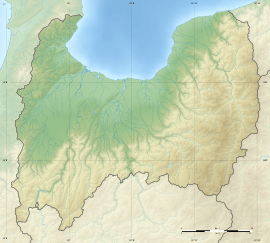Kamiichi Kurokawa Sites
Kamiichi Kurokawa Sites (上市黒川遺跡群, Kamiichi Kurosawa iseki gun) is a group of archaeological site in the town of Kamiichi, Toyama Prefecture in the Hokuriku region of Japan. It has been protected by the central government as a National Historic Site since 1981.[1]
上市黒川遺跡群 | |
 Kamiichi Kurokawa Sites  Kamiichi Kurokawa Sites (Japan) | |
| Location | Kamiichi, Toyama, Japan |
|---|---|
| Region | Hokuriku region |
| Coordinates | 36°42′53″N 137°24′09″E |
| History | |
| Periods | Heian to Kamakura period |
| Site notes | |
| Excavation dates | 1981 |
| Ownership | National Historic Site |
| Public access | Yes |
Outline
The National Historic Site designation encompasses three separate areas within Kamiichi which contain the ruins of a Buddhist temple, a cemetery, and a sutra mound built form the end of the Heian period through the Kamakura period, which are noteworthy both for their size but also for the quality of excavated items.
Ennenjiyama Sutra Mound
The Ennenjiyama Sutra Mound (円念寺山経塚) is actually a cluster of 24 sutra mounds, making it the latest cluster yet discovered in the Hokuriku region. The sutra containers include ceramics imported from China during the early Kamakura period and also include a number of Shingon Buddhism ritual implements from the late Heian through Kamakura periods.
Kurokawa Ueyama Cemetery site
The Kurokawa Ueyama Cemetery (黒川上山墓跡) was in use from the end of the Heian period through the middle of the Kamakura period. Located on a hillside, some 67 densely-packed graves have been discovered.
Shingō-ji
The temple of Shingō-ji (伝真興寺跡) is mentioned in historical records, but its exact location is not documented. This site was found to contain the foundations of monumental gate, pagoda, Hon-dō and a pond in a configuration which is in accord with what is known of the Shingon-sect temple of Shingō-ji in historical records.
References
- "上市黒川遺跡群". Cultural Heritage Online (in Japanese). Agency for Cultural Affairs. Retrieved 25 December 2017.
External links
- Kamiichi Town official site (in Japanese)